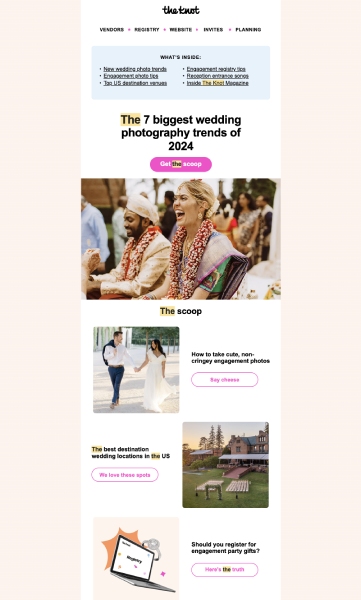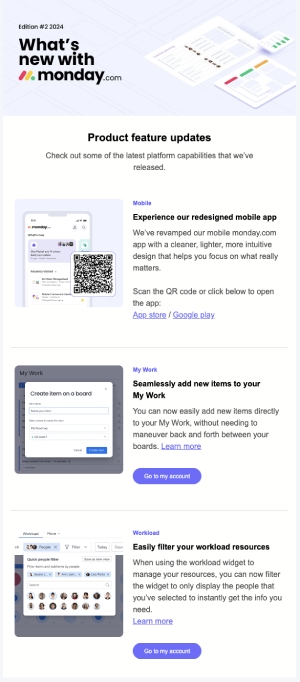Email marketing is a category of its own. It’s not like social media marketing, where you’re competing with hundreds of other brands for your audience’s attention, and it’s not like search engine optimization (SEO) marketing either, where you need to do intensive keyword research and planning to match your audience’s needs and interests. But it’s just as valuable a strategy for marketing your small business.
From my experience, what’s always made email marketing unique is that it’s a more personal, one-on-one form of communication compared to the other marketing strategies mentioned above. You’re only competing for your audience’s attention in their inboxes. But once they open your email, you have their attention for the whole page. That’s no small thing.
But that also means the emails you send should be worth your recipients’ time and attention. You wouldn’t want your recipients to open your email and then immediately close it again, or worse, mark it as “spam.” And I know firsthand that thinking up good email marketing ideas that genuinely engage your audience can be challenging, which is why I’ve compiled some of the best below. Keep reading for 15 effective email campaign ideas to promote your small business.
1. Send Newsletters
One of the most essential email marketing ideas I always recommend for small businesses is to send regular newsletters. Newsletters are a well-established way to keep your customers engaged with your brand and help keep it top of mind. It’s overall a simple and cost-effective way to build your business’ brand presence and create an engaged community.
Email newsletters are also a pillar in content marketing. Sending valuable content to your subscribers that addresses their needs and questions increases your brand’s credibility and builds their trust in your business. Plus, newsletters are also simple enough to make: if you already have a blog or other existing content, you can reuse it for your newsletter.
To get started with your newsletter, first decide on its theme and content. It can be as simple as a weekly roundup of your most popular blogs or sneak peeks of upcoming products or updates from your brand, like the examples above. Then, decide on the frequency of your newsletter. Set up your email list and layout on your email platform, and you’re ready to send your newsletter.
2. Offer Exclusive, Email-only Perks
One of the things that makes email marketing unique is that it’s non-intrusive, unlike social media or digital ads. Your subscribers willingly opt in to receive your marketing emails—it’s a fundamental part of permission-based email marketing. One way to reward those subscribers is by offering them exclusive, email-only perks and rewards.
Exclusive perks make your subscribers feel valued and special, which in turn fosters brand loyalty. These perks can be anything from exclusive access to events to special email-only discounts and gifts, like in the example below.
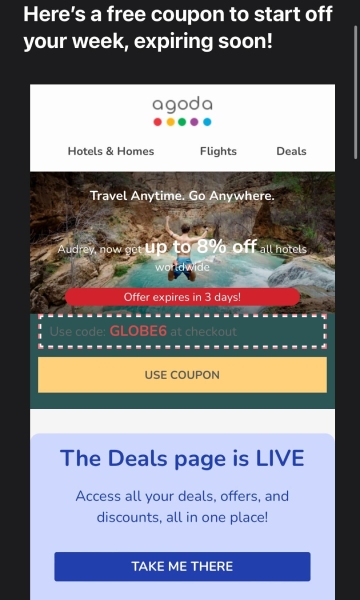
Exclusive email-only perks and rewards like a free coupon make customers feel special, which helps foster brand loyalty. (Source: Agoda)
Getting people to sign up for your emails is just half the battle in email marketing—the other half is keeping them engaged with your brand so they turn into loyal customers. Offering exclusive perks is one of the best ways to make them feel valued members of your community.
3. Create Click-to-purchase Product Catalogs
Physical product catalogs are a staple in direct mail marketing. You’ve probably even received a few of them in your mailbox. They’re a simple, straightforward, and well-established way of showing audiences the products or services your brand offers.
One way to update your product catalogs is to send them digitally through email instead of through physical post. In fact, emails allow far more possibilities because they allow interactions and engagement with your recipients. An example of this is by sending click-to-purchase product catalogs, which are essentially product catalogs with the option to immediately make a purchase via the click of a button, like in the example below.
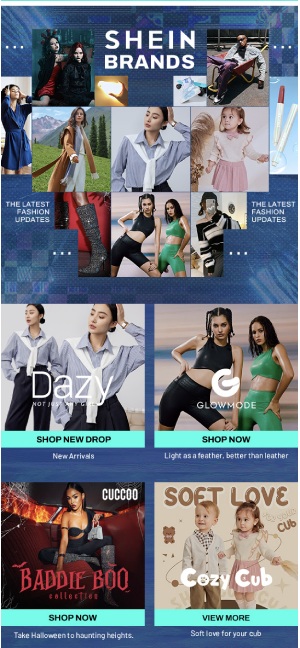
Click-to-purchase product catalogs can lead your subscribers to complete a purchase directly from their inbox. (Source: SHEIN)
Click-to-purchase product catalogs like this are one of the simplest effective email marketing ideas—especially if you have an ecommerce store—because they can easily lead your recipients down the sales funnel. Beyond simply showing off your products, they can easily turn your recipients into customers.
4. Add Interactive Elements Like Polls & Quizzes
Interactivity is one of the best benefits of email marketing. Including even one interactive element in your emails makes your content more interesting and engaging to your recipients and instantly makes your brand far more memorable among the sea of others in your recipients’ inboxes.
One of the best email marketing campaign ideas to leverage this is to add interactive elements like polls and simple quizzes to your email, like in the example below by cosmetics brand Shiseido.
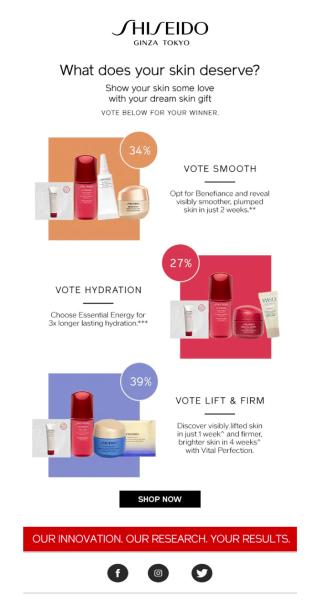
Cosmetic brand Shiseido’s simple email poll instantly makes it much more engaging and memorable. (Source: Litmus.com)
By including a quiz instead of simply showing off their products, the brand encourages its recipients to be more than passive receivers of their content, and instead be active participants. It’s a simple upgrade, but gives a significant boost to your brand recall later on.
Beyond polls and quizzes, other interactive elements you can add to your emails are calendar booking functions or sign-up forms, e.g., if you owned a service-based business like a parlor or were offering workshops and tutorials. These not only boost your emails’ engagement, but can also generate new leads.
5. Send Surveys
Emails aren’t all just for marketing. They can also help you gather relevant information about your customers and their experience with your business. The best way to do that is by sending surveys via email.
There are many types of email surveys you can send, depending on your business’ needs. You can send simple customer satisfaction surveys for customers to rate their experience purchasing from your store. Or, you can even send longer surveys to help inform your next product release or update—email’s long-form format is also a suitable fit.
With email, you can also be as creative and memorable as you like, as in the example below. Plus, beyond helping you gather valuable customer data, surveys also signal to your customers that you care about their experience.
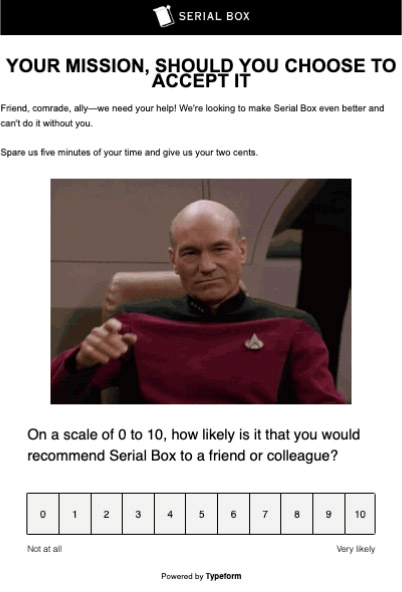
Email surveys like these can give you valuable insights about your customers, and they’re simple to make. (Source: Serial Box)
6. Request Customer Reviews
Reviews are the lifeblood of any small business. They increase your credibility to other audiences, and they act as a form of word-of-mouth marketing. Customers like reading reviews from fellow customers because they find them more relatable and trustworthy than traditional advertising. In fact, reading reviews is now a routine part of the customer experience: according to a 2023 study, 98% of customers read reviews before trying out a brand.
Online reviews can also increase your local search engine optimization (SEO), which is why they’re overall one of the best email blast ideas for small businesses. Like surveys, one of the best ways to request reviews from customers is by sending them an email—most customers are usually happy to spend a few minutes writing a review.
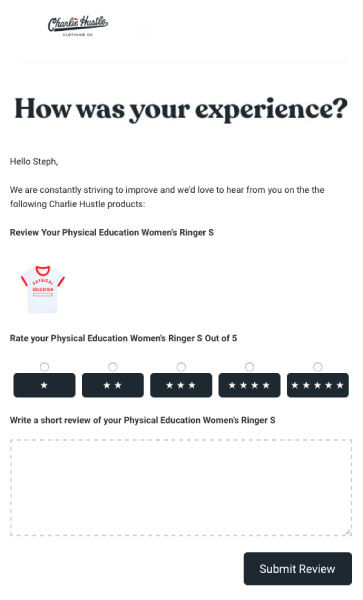
Requesting customers to leave reviews is one of the most useful email marketing ideas for your small business. (Source: Reviews.io)
When requesting reviews from your customers, be sure to make the experience as seamless as possible. Keep your request short and friendly, and include a link that sends them to your review page (whether it’s your Google Business Profile or Yelp page). Or even better, include the review within the email itself, like in the example above.
7. Invite Repeat Customers to a Loyalty Program
If you’ve ever been part of a brand’s loyalty program or membership, you’re probably familiar with how it can feel like being part of an exclusive special club. That’s how loyalty programs work: they create a sense of exclusivity among your customers, which in turn fosters brand loyalty and can even convert your customers into lifelong brand ambassadors.

Inviting repeat customers into loyalty programs can help foster brand loyalty. (Source: Vogue)
So if you have customers who’ve made repeat purchases from your brand in the past, inviting them to a loyalty program as a reward can help secure their loyalty. Find out more about how to create loyalty programs.
8. Offer Content They Can Download & Keep
Email marketing is one of the most prominent forms of content marketing, which is why one of the best email marketing content ideas is to offer your recipients valuable content they can download and keep, such as an e-book, template, or workbook. Downloadable content like these give your audience a piece of your brand they can keep wherever they go.
Always make sure to offer truly valuable and helpful enough content that your recipients will want to download. For instance, if you own a home landscaping service, an example of valuable content would be an e-book with a guide to maintaining your landscape at home. Or, if you were a real estate agent, you might offer tips on investing in real estate. Be sure that the content you offer aligns with your customers’ needs, wants, and interests.
While hosting your downloadable content on your website is all well and good, there’s a good chance it isn’t garnering as much traffic or views compared to other high-traffic pages on your site. Sending them directly via email can potentially grant you a more streamlined and focused audience who are more likely to read and download your content.

An example of a downloadable e-book sent via email (Source: Smartly.io)
9. Greet Them on Special Occasions
When it comes to good email marketing campaigns, one thing I always keep in mind is to “surprise and delight” customers, which essentially means to make customers feel good when they don’t expect it. One of the most tried-and-true email marketing ideas to do this is to send emails during special occasions like birthdays, holidays, or anniversaries, or even on national holidays like New Year’s or Valentine’s Day.
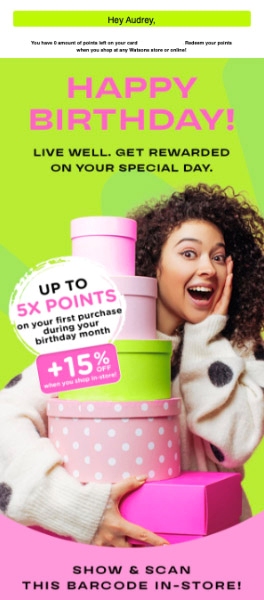
Greeting your customers on their special occasions can foster brand loyalty. (Source: Watsons)
Everybody likes to be greeted on special occasions, which is why they’re one of the simplest yet enduringly effective email marketing campaigns to keep customer engagement high. And to make your emails even more special, you can offer special gifts or discounts. They’re also simple enough to set up: you can easily create an automated drip campaign on most email platforms to automatically send out emails on certain dates.
10. Automate Welcome Emails
Getting people to sign up for your marketing emails is only the beginning of the email marketing journey. The real work begins after they sign up—you’ll need to keep them engaged and interested in your emails. One of the best ways to start establishing that rapport is by sending welcome emails right after they subscribe to your brand.
Welcome emails (aka “new subscriber” emails) are relatively short and simple, and they can also be automated with most email platforms. But they’re also important to get right because they’re often the first point of contact your subscribers have with your brand, so you need to be sure you make a good impression.
When creating your welcome email, keep your message short, simple, and friendly, and include elements of your brand identity such as your brand colors and brand voice. You can also offer a welcome discount to encourage a first purchase, like in the example below.
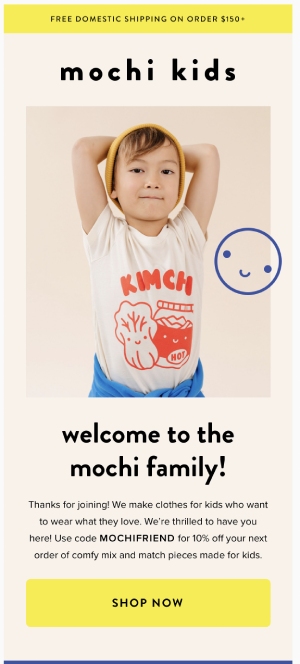
Welcome emails are often your first point of contact with new subscribers, and therefore need to make a good impression. (Source: Mochi Kids)
11. Send Post-purchase Product Guides
The best email campaign ideas are all about creating positive customer experiences, and that includes even after they’ve purchased from your brand. And while a simple “thank-you” email is good enough, you can also go the extra mile and send them a product guide about the item they purchased. This shows that you genuinely care about providing your customers with a good experience, and can even boost your chances of getting a repeat purchase.
Product guides are also a form of content marketing. This means the content you send needs to be genuinely valuable and helpful to your users. Some examples of content you can send are instructions and tips on how to use their new product, like in the example below, or links to blog posts on your website. The key is to make sure the customer journey doesn’t simply end after their purchase but to extend it further so they come back again for more.

Post-purchase product guides extend the customer journey even after purchase. (Source: Really Good Emails)
12. Invite Them to a Weekly Challenge
When it comes to garnering online engagement for your brand, a proven strategy is to hold regular challenges that encourage your online community to join. Creating an active online community is one of the best things you can do for your business because it helps secure a loyal customer base later on, and it keeps steady online engagement for your brand.
Regular challenges like these are simple and effective because they encourage customers to engage with your brand and create an active online community. To encourage participation, make your challenge simple enough to join and make sure to play into what makes your brand unique, like in Canva’s Weekly Design Challenge below, which encourages Canva users to upload designs made on the platform on a specific theme.
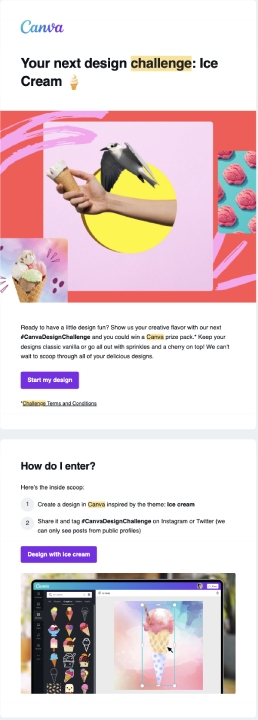
Weekly challenges like these aren’t just for social media. They can also help you build an active community via email. (Source: Canva)
You can be as creative as you like in the challenges you host. For instance, fitness brands can invite customers to join fitness challenges. Or, if you own a clothing brand, you can encourage customers to share images of their outfits. Just be sure your challenge is directly related to your brand.
13. Write Your Emails Like Personal Correspondence
Thousands of marketing emails are sent every day, and it can seem an impossible task to catch your audience’s attention. But one of the best email marketing ideas to help your email stand out from the sea of others is to write it like personal correspondence. Think of it as the earlier days of email in the ’90s, before email marketing became popular.
In a hyper-digital world where every brand is constantly using eye-catching visuals and clickbait-y headlines to catch audience attention, it might just be the opposite that works. Simple and straightforward emails that get to the point simulate the feel of a genuine email instead of a marketing strategy, which can be more effective at capturing and holding your audience’s attention, just like in the example below.
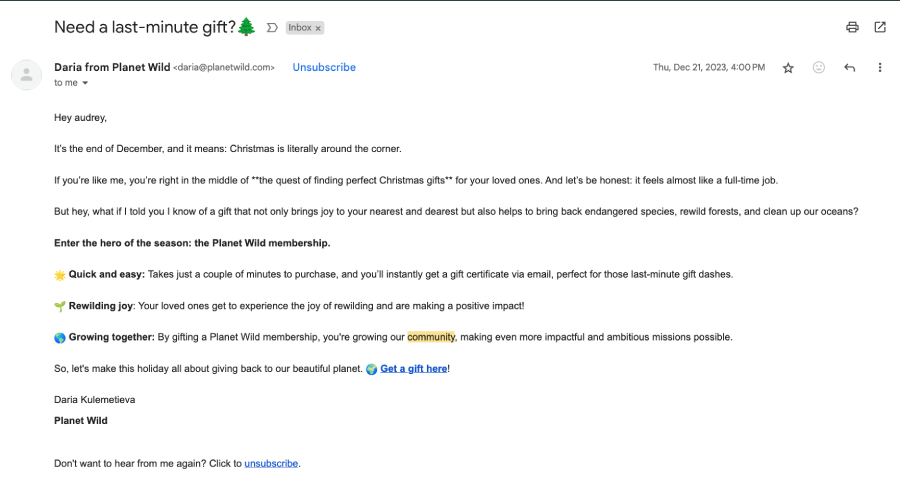
Designing your email like personal correspondence can make it stand out among countless other marketing emails. (Source: Planet Wild)
Of course, always make sure your overall email, from your content’s tone to its layout, still matches your overall branding.
14. Feature Your Customer Community
One of the best ways to build an active online community is to feature content from your community. Customers like seeing content by fellow customers because it’s more authentic and relatable, and overall makes your brand feel more trustworthy. At the same time, featuring your customers in your content makes them feel appreciated and fosters their loyalty to your brand.
This type of marketing that uses content by your users is called user-generated marketing, and it’s one of the most cost-effective marketing strategies today to build an online community. This can mean featuring case studies of customers’ experience with your brand, images they’ve shared of your product, or even some of your best online reviews.

Customer testimonials are one of the best email campaign ideas to lend a sense of authenticity to your brand. (Source: Drip.com)
15. Use Email to Support Other Marketing Campaigns
Email marketing is one of your most essential marketing strategies, but it shouldn’t be your only one. The most effective email campaigns I’ve run are always coupled with campaigns on other channels, like social media and SMS marketing. This is why when thinking up new email campaign ideas, one of the first things you can do is evaluate whether you’re running any other campaigns on other channels, and then see how you can support them via email.
For instance, if you’re running a social media campaign to promote a sale, you can support that by sending promotional emails. Or, if there are specific blog posts you want more visibility and traffic on, you can highlight them in your email newsletters. Email is one of your most versatile marketing channels, and there are countless ways to leverage it to make your other campaigns even more impactful.
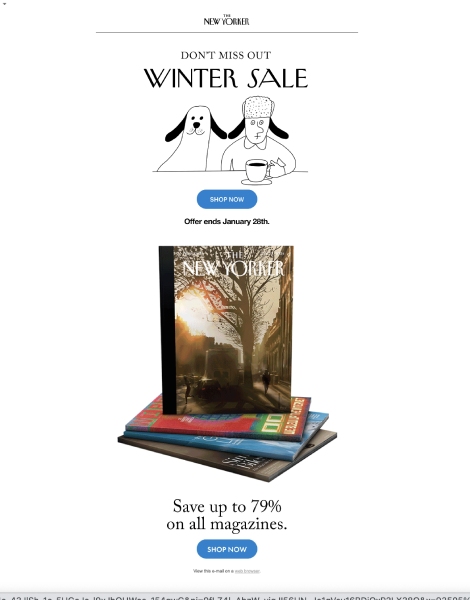
Supporting your other marketing campaigns with email can make them far more impactful, like this example from The New Yorker promoting a winter sale. (Source: The New Yorker)
6 Do’s & Dont’s of Email Marketing
While the email marketing ideas above can help you get a head-start on your email strategy, there are other things to also keep in mind when doing email marketing. Its uniqueness as a platform means there are some specific ways to get the most out of your campaign. Here are some of the biggest do’s and dont’s when doing email marketing:
- Do email A/B testing: Email A/B testing is your best way to navigate the different variables of email marketing and determine the best combination for your business. A/B tests save you a lot of time, effort, and money and help you build precise and effective campaigns.
- Do have an email marketing plan: No successful marketing strategy comes about without a good plan, and the same goes for email. Having a plan lets you plot out your email campaigns ahead of time, keep track of your budget, and create better campaigns in the future. Learn how to create an email marketing plan.
- Do choose the best platform for your business: Not all email marketing platforms are equal. Some are built especially for beginners, while others offer advanced analytics for experts, and others still specialize in automations. Choose the best email platform that fits your business’ specific needs, including your potential needs as you scale up later on. Find out more in our guide to the best email marketing software.
- Don’t use wordy, overly formal language: No one wants to open an email and read a thesis paper. Emails are conversations—think back to the early days of email in the ’80s and ’90s. Use friendly, conversational, easy-to-understand language to better engage your readers.
- Don’t combine multiple CTAs: Aside from being conversational, your emails should also be simple to understand. This means each email you send should only have one call to action (CTA), whether it’s to visit your blog or register for an event. Mixing multiple CTAs in an email will only confuse your audience.
- Don’t focus on email alone: Your target audience isn’t on email alone. They’re probably also on social media, on search engines, and on other platforms. This means you’ll need an omnichannel marketing strategy. Email marketing is most effective when it’s combined with other marketing channels.
While the points above cover the most essential do’s and don’ts, they’re only the tip of the iceberg in the wide world of email marketing. For a more comprehensive list, read our article on email marketing best practices for small businesses.
Frequently Asked Questions (FAQs)
To create a successful email marketing strategy, you’ll first need to clearly outline your objectives. Then, research your target audience’s needs and interests from your brand, and then build an email list with that audience. Plan a content strategy addressing their interests and needs, and choose the best email platform that suits your business. Finally, do regular email A/B testing to refine the best email strategy for your business.
You can be creative in email marketing in its design and content. For instance, use eye-catching designs in your content and incorporate videos, GIFs, and interactive elements. You can also use friendly, conversational language and write catchy and personalized subject lines. Research your competitors’ email strategy and see what you can do to stand out.
Some of the best email marketing strategies to increase customer engagement are sending newsletters and surveys and creating weekly challenges for your recipients. Some effective email strategies to foster brand loyalty are sending greetings on special occasions (like birthdays and anniversaries) and offering exclusive, email-only perks. And, to help drive sales, one of the best email campaign ideas is to offer limited-time promotions.
Bottom Line
Email marketing is invaluable to your small business’ marketing strategy. It can grow your brand awareness, keep your customers engaged, foster loyalty, and even drive sales. In all, it’s a helpful, versatile, and cost-effective tool in every stage of the customer journey. Use the email marketing ideas above to help you get started.
